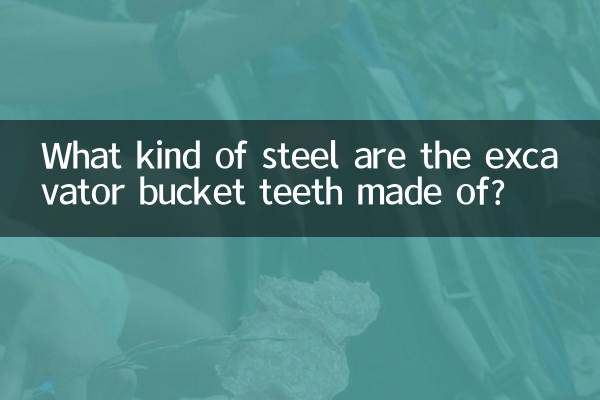What kind of steel are the excavator bucket teeth made of? Revealing the material secrets of core components of engineering machinery
In the field of engineering machinery, excavator bucket teeth are the core components that directly contact materials, and their material selection directly affects work efficiency and service life. This article will focus on"What kind of steel are the bucket teeth of excavators made of?"This topic combines the hot topics and hot content on the entire network in the past 10 days, analyzes it from the perspectives of material properties, industry standards, market trends, etc., and provides structured data for reference.
1. Common steel types for excavator bucket teeth

The bucket teeth of the excavator are mainly made of high wear-resistant alloy steel, and the hardness and toughness are improved through a heat treatment process. The following is a comparison of mainstream steel types and properties:
| Steel type | Main ingredients | Hardness (HRC) | Wear resistance | Typical applications |
|---|---|---|---|---|
| High manganese steel (ZGMn13) | Mn 11%-14%, C 1.0%-1.4% | 18-22 (initial) | High (hardened after impact) | Mining and sand and gravel operations |
| Low alloy wear-resistant steel (such as NM360) | Cr, Mo, B and other alloying elements | 35-45 | Middle to high | General earthworks |
| Ultra-high chromium cast iron (Cr20-28%) | Cr 20%-28%, C 2.5%-3.5% | 58-65 | extremely high | extreme wear environment |
2. Popular discussion focus on bucket tooth materials
1."Work hardening" properties of high manganese steel: Recently, industry forums have discussed that the hardness of high manganese steel can be increased to above HRC 50 under impact load, but attention should be paid to its low initial hardness.
2.Breakthroughs in composite materials technology: Some manufacturers have launched "steel base + tungsten carbide coating" bucket teeth, which have a 300% increase in wear resistance, but the cost is higher.
3.Environmentally friendly material trends: New EU regulations require the content of heavy metals such as lead and cadmium in bucket tooth materials to be less than 0.1%, promoting the development of low-carbon alloys.
3. Market dynamics and user selection suggestions
According to the sales data of the e-commerce platform in the past 10 days, the material selection of bucket teeth shows the following trends:
| Material | Sales proportion | Average unit price (yuan/unit) | User praise rate |
|---|---|---|---|
| High manganese steel | 52% | 120-200 | 89% |
| low alloy steel | 35% | 80-150 | 85% |
| Composite material | 13% | 300-500 | 93% |
4. How to extend the life of bucket teeth?
1.Material selection to match working conditions: Low alloy steel can be selected for soft soil operations, and ultra-high chromium cast iron is recommended for rock conditions.
2.Check regularly for wear: When the bucket tooth length wear exceeds 15%, it needs to be replaced to avoid damaging the bucket base.
3.Welding process optimization: Recent research shows that preheating to 200°C can reduce welding cracks in high manganese steel.
Conclusion
The selection of steel for excavator bucket teeth requires comprehensive consideration of cost, working conditions and technological development. With the advancement of new material technology, lighter and longer-lasting solutions may appear in the future. It is recommended that users pay attention to industry trends and regularly update equipment accessories to improve economic benefits.

check the details

check the details